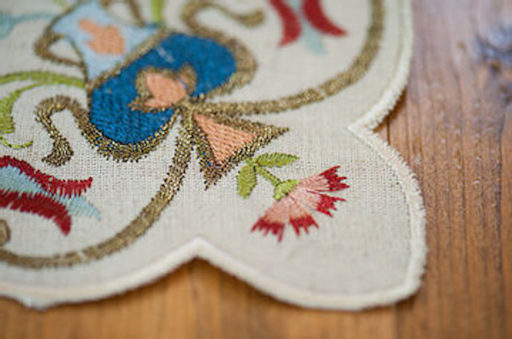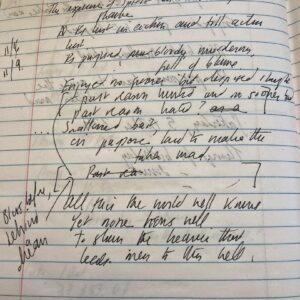Last Saturday afternoon, I spent a couple of hours pulling out embroidery stitches with a seam ripper. I’d had the embroidery kit for a couple of years, in a basket on top of my bedroom bookcase, and had only gotten up my courage to start it in the past month, on one of the lazy Monday midwinter holidays when I finally had nothing to do.
At first I sat on the sofa, then as the afternoon wore on and the light faded, I moved to the dining room table. In our small house, the table functions as an alternate workspace, and there I had the benefit of the overhead light from the chandelier. At the end of two hours, though, my eyes were dry and my fingertips stung, and I shook my head to clear out the haze.
I bought the kit—for a table runner with an angular, Palestinian-style cross stitch design—at a retreat from a priest’s wife and all-around mensch who’s a leading maker of Orthodox priestly vestments, and who has a business selling patterns taken from Mediterranean folk embroidery. Two years later, I’d finally gotten going, and had backstitched the border almost along one whole side, when I measured the distance from the edges, and realized that my heretofore straight line had started to wander.
I sighed. The fabric for the runner is ground cloth, with a weave even smaller and harder to navigate than the Aida cloth typically used for counted cross stitch. I lifted the cloth and wondered if, perhaps by pulling it a little in one direction or another, I could just make it look O.K., and not have to undo all the work I had done.
To do that, though, it occurred to me, would be an act of cowardice, and a refusal to learn a lesson I’ve long sought to avoid. In the domestic realm, I come from a family of women—all with great taste and aesthetics—who by temperament and interest are not painstaking and exact. All of them are masters of Throwing Things Together and Calling In the Professionals, from cooking to decorating. Presentation is all.
I’m just not that good at it, says the voice in my head.
And so rises the temptation to fudge it a little, to hide behind the kind of message you see on expensive clothing: “random surface inconsistencies are indicative of the hand-crafted nature of the product.” And the second voice coming close behind: does it matter, if it still looks good?
For years, I stood behind that second voice, but increasingly I think of it as the snake in the garden slithering behind me, prompting me to skate over the hard work of creation in favor of the shiny, easy surface.
This is true not only in the realm of Mediterranean folk embroidery, but in the memoir draft I’m finally close to finishing, which sits at around 90,000 words pre-revision. Distracted and bored, I’m ready to be done with it, to pull together its edges, however imperfectly, into some sort of final form.
This desire, I see, is a function both of laziness and pride: laziness that I can’t reign in my wandering attention to keep my eyes on the goal, and pride in that I’m afraid that if it can’t be good, it can nonetheless look good, and maybe I will get away with it. In that sense, I fear there’s a fundamental dishonesty to both the literary work and the embroidery. (I fear this, in fact, about these very words I’m writing right now, on the lip of the deadline, coasting forward on the momentum of the last minute.)
In this, at least, I am not alone: I’ve noticed that many, many of the most hailed contemporary memoirs and novels today speed to their finish. The twentieth century Agrarian-adjacent novelist Caroline Gordon famously described the structure of the novel as optimally being like a Roman arch, with all pieces in place to shoulder the weight of the whole. (Flannery O’Connor, a master of literary structure herself, makes reference to this more than once in her Letters.)
Most things I read today, though, suffer from an inconsistent shape that tends to set forth a baggy, character-driven psychological development for the first 200 pages of a 300 page book, that then resolves with the machinations of an action film in the last 100. My sisters and sister-in-law and I recently had a zoom book club on Ann Patchett’s lauded novel The Dutch House, and while all of us liked it, most of us felt that the plot elements wrapped up a little too neatly, and dazzlingly; like movies, the satisfaction quotient for many novels seems amped up by how wealthy and charmed the characters’ circumstances are. I still liked the novel, but felt something of a sugar crash once I was done reading.
It’s not just Ann Patchett. I don’t know about you, but I felt the same way about Jonathan Franzen’s Freedom, though less so The Corrections. I did not feel that way about Janet Peery’s The Exact Nature of Our Wrongs, a novel I loved so much that I talked the sisters into reading it for our next book club, and which has a structure that pulls together with the exact right nuance—like the magic moment when the string tethered to a ship in a bottle is pulled and the sails of the ship rise up in all their dimensions.
That must be hard, to evoke a perfection like that. I’d love to hear Janet Peery’s thoughts on how she did it; and Janet Peery, if you are reading this, please do reach out.
And I’m sitting here with my own impatience and pride and distraction, because I am trying to think about how I can end this essay—in this world of women, I still have to teach Sunday School and write some thank-you notes and encourage my child to get off the television—and how I can finish writing my book draft that people have been asking about for years?
I want the sheen of the easy finish. Don’t I deserve it, by now? But that’s the dishonesty everywhere now, from The New York Times to CPAC. Instead, the task remains, to take the uneven thread of words, just as with the backstitches of embroidery, and pull them out, and pull them back in. This is not just writing or sewing, but soul-making, too:
Until everything is firm and whole.
Caroline Langston was a regular contributor to Image’s Good Letters blog, and is writing a memoir about the U.S. cultural divide. She has contributed to Sojourners’ God’s Politics blog, and aired several commentaries on NPR’s All Things Considered, in addition to writing book reviews for Image, Books and Culture, and other outlets. She is a native of Yazoo City, Mississippi, and a convert to the Eastern Orthodox Church. She lives outside Washington, D.C., with her husband and two children.





